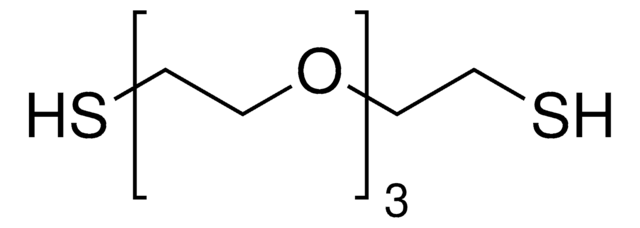673110
Triethylene glycol mono-11-mercaptoundecyl ether
95%
Sinónimos:
(11-Mercaptoundecyl)tri(ethylene glycol)
About This Item
Productos recomendados
Quality Level
assay
95%
refractive index
n20/D 1.476
density
0.995 g/mL at 25 °C
storage temp.
−20°C
SMILES string
OCCOCCOCCOCCCCCCCCCCCS
InChI
1S/C17H36O4S/c18-10-12-20-14-16-21-15-13-19-11-8-6-4-2-1-3-5-7-9-17-22/h18,22H,1-17H2
InChI key
FASSFROSROBIBE-UHFFFAOYSA-N
Categorías relacionadas
General description
Application
Storage Class
10 - Combustible liquids
wgk_germany
WGK 3
flash_point_f
>230.0 °F
flash_point_c
> 110 °C
ppe
Eyeshields, Gloves
Elija entre una de las versiones más recientes:
¿Ya tiene este producto?
Encuentre la documentación para los productos que ha comprado recientemente en la Biblioteca de documentos.
Los clientes también vieron
Artículos
Inorganic nanomaterials are tunable by size, shape, structure, and/or composition. Advances in the synthesis of well-defined nanomaterials have enabled control over their unique optical, electronic, and chemical properties stimulating tremendous interest across a wide range of disciplines. This article illuminates some of the recent research advances of inorganic nanoparticles (NPs) in optoelectronics applications.
Self-assembled monolayers (SAMs) have attracted enormous interest for a wide variety of applications in micro- and nano-technology. In this article, we compare the benefits of three different classes of SAM systems (alkylthiolates on gold.
Nuestro equipo de científicos tiene experiencia en todas las áreas de investigación: Ciencias de la vida, Ciencia de los materiales, Síntesis química, Cromatografía, Analítica y muchas otras.
Póngase en contacto con el Servicio técnico![2-{2-[2-(2-Mercaptoethoxy)ethoxy]ethoxy}ethanol 97%](/deepweb/assets/sigmaaldrich/product/structures/130/969/7d2ec2b4-e0f1-4836-aeb2-139994173612/640/7d2ec2b4-e0f1-4836-aeb2-139994173612.png)












